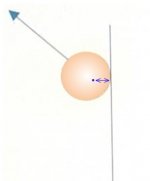How does fractional aiming exactly define the vast majority of shots?
pj
chgo
The traditional 5 lines or "quarters" fractional aiming method doesn't, but the fractional system in the Poolology book does provide an aim line by using some simple math, no guesswork, no trial and error. It gives you the correct cb-ob relationship needed to pocket the ball, which does require some spatial skills. Then all the player has to do is deliver the cb to where it needs to be.
People with great spatial skills can recognize where the cb needs to be without using any system or method other than just looking at the shot. Imo that should be the ultimate goal, to just see the shots and automatically recognize where where the cb needs to be. For most of us this involves a lot of repetition, successful repetition, before we begin to automatically just see the shots. For others it seems to never fully develop, more than likely due to inconsistent stroke mechanics or lack of table time.
One must be able to consistently deliver the cue in a manner to send the cb to where it needs to be. Developing dependable and consistent shot recognition is typically something that occurs after one develops a consistent enough stroke to send the cb to where they "think" it needs to be based on their best estimate of ghostball or contact point or fraction or whatever... Eventually, with enough practice, thinking becomes knowing. Prior to developing a good stroke, the player really doesn't know if a missed shot is due to faulty aiming estimations or faulty stroke. That's why/how HAMB works -- the player develops stroke and aiming skills simultaneously through tons of trial and error. One without the other makes it a time-consuming journey.
But the process can come about much quicker by reducing the trial and error involved with aiming. In other words, I believe if you could give a player a great consistent stroke, they could develop aiming skills fairly quickly. Vice versa, if you could provide accurate aiming skills, the player could develop a consistent stroke fairly quickly. But simply giving someone a good stroke isn't possible. They have to develop it. You can, however, give someone good aiming. For example, you can stand by every shot and point at a spot on the ob or the cloth and say "Aim here." If the shot is missed it is surely not because the player didn't know where to send the cb. The miss can be attributed to stroke mechanics/cue delivery. Without someone or some method that tells you exactly where to aim, you must rely on your best experienced estimates/guesses, and misses could be attributed to either faulty aiming estimations or faulty stroke mechanics.
